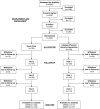A Lifestyle Physical Activity Intervention for Patients with Chronic Obstructive Pulmonary Disease. A Randomized Controlled Trial
- PMID: 26785249
- PMCID: PMC5018892
- DOI: 10.1513/AnnalsATS.201508-508OC
A Lifestyle Physical Activity Intervention for Patients with Chronic Obstructive Pulmonary Disease. A Randomized Controlled Trial
Abstract
Rationale: Physical inactivity is associated with poor outcomes among patients with chronic obstructive pulmonary disease (COPD).
Objectives: To determine effectiveness of a behavioral intervention intended to increase daily physical activity with the goal of improving health-related quality of life and functional performance.
Methods: We conducted a randomized trial among patients with COPD cared for in primary care and pulmonary clinics. The patients were at least 45 years of age and eligible for pulmonary rehabilitation. All patients received self-management education during a 6-week run-in period. Subsequently, patients were randomized to usual care or the intervention delivered over 20 weeks.
Measurements and main results: Co-primary outcomes were change from baseline in Chronic Respiratory Questionnaire dyspnea domain score and 6-minute-walk distance measured at 6, 12, and 18 months after randomization. A total of 325 patients were enrolled, with 156 randomized to receive usual care and 149 to receive the intervention. At 18 months, there was no overall statistical or clinically significant change in the dyspnea domain in either group. However, for 6-minute-walk distance, there were statistically significant declines in both groups. In contrast, 6-minute-walk distance remained stable (5.3 m; P = 0.54) among patients in the intervention group with moderate spirometric impairment, but it was associated with clinically and statistically significant declines (-28.7 m; P = 0.0001) among usual care patients with moderate spirometric impairment. Overall, there was no increase in adverse events associated with the intervention, which was associated with a lower prevalence of hospitalization for COPD exacerbations (28.3%) compared with usual care (49.5%).
Conclusions: During this 18-month trial among outpatients with COPD, a health coach-based behavioral intervention did not improve scores in the dyspnea domain of the Chronic Respiratory Questionnaire or 6-minute-walk test distance. However, subgroup analyses suggested that there may be differential effects for specific outcomes that vary with severity of COPD. Specifically, benefits of this low-intensity intervention may be limited to 6-minute walk distance among patients with moderate spirometric impairment. Clinical trial registered with www.clinicaltrials.gov (NCT1108991).
Trial registration: ClinicalTrials.gov NCT01108991.
Keywords: chronic obstructive pulmonary disease; physical activity; pulmonary rehabilitation; randomized trial; self-management.
Figures



Comment in
-
One Step at a Time. Lifestyle Physical Activity Interventions.Ann Am Thorac Soc. 2016 May;13(5):586-7. doi: 10.1513/AnnalsATS.201601-039ED. Ann Am Thorac Soc. 2016. PMID: 27144787 No abstract available.
References
-
- Watz H, Pitta F, Rochester CL, Garcia-Aymerich J, ZuWallack R, Troosters T, Vaes AW, Puhan MA, Jehn M, Polkey MI, et al. An official European Respiratory Society statement on physical activity in COPD. Eur Respir J. 2014;44:1521–1537. - PubMed
-
- Spruit MA, Singh SJ, Garvey C, ZuWallack R, Nici L, Rochester C, Hill K, Holland AE, Lareau SC, Man WD, et al. ATS/ERS Task Force on Pulmonary Rehabilitation. An official American Thoracic Society/European Respiratory Society statement: key concepts and advances in pulmonary rehabilitation. Am J Respir Crit Care Med. 2013;188:e13–e64. - PubMed
Publication types
MeSH terms
Associated data
Grants and funding
LinkOut - more resources
Full Text Sources
Other Literature Sources
Medical

